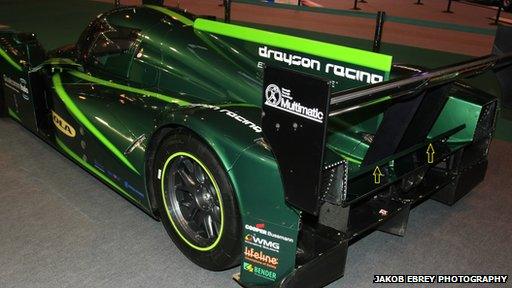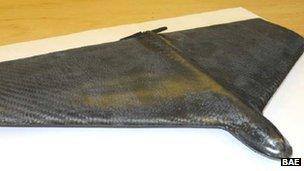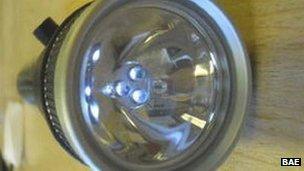BAE provides details of 'structural battery' technology
- Published

The Lola-Drayson electric car is an opportunity to test the structural batteries which will power some on-board systems. In this image a battery is indicated with yellow arrows
Torches, drones and an electric Le Mans racing car are all test-beds for a new kind of "structural battery", BAE Systems has said.
The batteries use carbon fibre and can form part of the body of a device.
By effectively building the power source into the fabric of an object they can save weight.
BAE is testing the technology in the Lola-Drayson B12/69EV, which aims to become the world's fastest electric car.
The firm said it hoped the battery material will eventually be as easy to work with as existing carbon fibre.
"It's only when you shake rattle and roll these things on a real-world platform that you uncover issues," Stewart Penney of BAE Systems told the BBC.
Last year the company revealed that it had constructed a torch and a small unmanned aerial vehicle out of the battery material.
Clever carbon
The new devices are, according to BAE, more than just traditional batteries in an different shaped case. Potentially the technology could be a substitute for existing carbon-composite structural materials.

The batteries have been used to power small unmanned aerial vehicles BAE said.
"There are number of people that will build a battery shaped like a beam, for example, but fundamentally that is just an odd-shaped battery, it isn't a structural battery," Mr Penney said.
"The beauty of what we've got is that, when it's fully developed, a company will be able to go out and buy what is a standard carbon-composite material, lay out the shape, put it through the curing process and have a structural battery," he said.
In order to achieve this BAE said it had "merged battery chemistries into composite materials".
"You take the nickel base chemistries and there are ways you can integrate that into the carbon fibre," Mr Penney explained.
While applications in military hardware and motor-racing suggest a big price tag BAE believes it can make structural batteries relatively inexpensive.
"The goal, and we are still working towards it, is to have a material that isn't significantly more expensive than carbon fibre," Mr Penney said.
Combat experience
BAE began work on the project as part of an effort to lighten the burden of troops carrying electronic items.

BAE produced a torch made from the structural batteries.
In a press release BAE set out a number of futuristic applications "from tents with their own power supply to making electric blankets a literal reality".
However, the power density of the batteries, the energy they can store for a given weight, is currently quite low - about a third that of a car battery, and a 10th that of the lithium-based batteries used in laptops and phones.
"We're not particularly high in terms of power density," Mr Penney admitted.
"We do have a lab demonstrator which is approaching the realms of a car battery," he added.
The batteries are nickel based. Originally intended for use in the military, they had to be resistant to fire and have a long working life.
"You need a battery chemistry that will last for many decades, you basically can't just take a wing off and throw it away as you would a mobile phone [battery]," Mr Penney said.
However, the company says it hopes to develop lithium-based batteries that will store more power in the future.
- Published11 February 2012